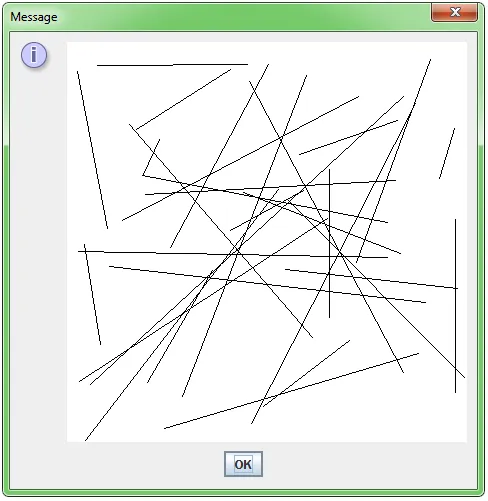我想知道Java中是否有能够从坐标(x1, x2)画到(y1, y2)的函数?
我想要做的是像这样:
drawLine(x1, x2, x3, x4);
我希望能够在代码的任何时候执行此操作,并使多行文本同时出现。
我尝试过这样做:
public void paint(Graphics g){
g.drawLine(0, 0, 100, 100);
}
我想知道Java中是否有能够从坐标(x1, x2)画到(y1, y2)的函数?
我想要做的是像这样:
drawLine(x1, x2, x3, x4);
我希望能够在代码的任何时候执行此操作,并使多行文本同时出现。
我尝试过这样做:
public void paint(Graphics g){
g.drawLine(0, 0, 100, 100);
}
一个非常简单的Swing组件示例,用于绘制线条。它内部保留了一个使用addLine方法添加的线条列表。每次添加新线条时,都会调用repaint来通知图形子系统需要进行新的绘画。
该类还包括一些用法示例。
import java.awt.BorderLayout;
import java.awt.Color;
import java.awt.Dimension;
import java.awt.Graphics;
import java.awt.event.ActionEvent;
import java.awt.event.ActionListener;
import java.util.LinkedList;
import javax.swing.JButton;
import javax.swing.JComponent;
import javax.swing.JFrame;
import javax.swing.JPanel;
public class LinesComponent extends JComponent{
private static class Line{
final int x1;
final int y1;
final int x2;
final int y2;
final Color color;
public Line(int x1, int y1, int x2, int y2, Color color) {
this.x1 = x1;
this.y1 = y1;
this.x2 = x2;
this.y2 = y2;
this.color = color;
}
}
private final LinkedList<Line> lines = new LinkedList<Line>();
public void addLine(int x1, int x2, int x3, int x4) {
addLine(x1, x2, x3, x4, Color.black);
}
public void addLine(int x1, int x2, int x3, int x4, Color color) {
lines.add(new Line(x1,x2,x3,x4, color));
repaint();
}
public void clearLines() {
lines.clear();
repaint();
}
@Override
protected void paintComponent(Graphics g) {
super.paintComponent(g);
for (Line line : lines) {
g.setColor(line.color);
g.drawLine(line.x1, line.y1, line.x2, line.y2);
}
}
public static void main(String[] args) {
JFrame testFrame = new JFrame();
testFrame.setDefaultCloseOperation(JFrame.DISPOSE_ON_CLOSE);
final LinesComponent comp = new LinesComponent();
comp.setPreferredSize(new Dimension(320, 200));
testFrame.getContentPane().add(comp, BorderLayout.CENTER);
JPanel buttonsPanel = new JPanel();
JButton newLineButton = new JButton("New Line");
JButton clearButton = new JButton("Clear");
buttonsPanel.add(newLineButton);
buttonsPanel.add(clearButton);
testFrame.getContentPane().add(buttonsPanel, BorderLayout.SOUTH);
newLineButton.addActionListener(new ActionListener() {
@Override
public void actionPerformed(ActionEvent e) {
int x1 = (int) (Math.random()*320);
int x2 = (int) (Math.random()*320);
int y1 = (int) (Math.random()*200);
int y2 = (int) (Math.random()*200);
Color randomColor = new Color((float)Math.random(), (float)Math.random(), (float)Math.random());
comp.addLine(x1, y1, x2, y2, randomColor);
}
});
clearButton.addActionListener(new ActionListener() {
@Override
public void actionPerformed(ActionEvent e) {
comp.clearLines();
}
});
testFrame.pack();
testFrame.setVisible(true);
}
}
将这些行存储在某种类型的列表中。当需要绘制它们时,迭代该列表并绘制每一行。就像这样:
屏幕截图

DrawLines
import java.awt.Color;
import java.awt.Dimension;
import java.awt.Graphics;
import java.awt.geom.Line2D;
import javax.swing.JOptionPane;
import javax.swing.JComponent;
import javax.swing.SwingUtilities;
import java.util.ArrayList;
import java.util.Random;
class DrawLines {
public static void main(String[] args) {
Runnable r = new Runnable() {
public void run() {
LineComponent lineComponent = new LineComponent(400,400);
for (int ii=0; ii<30; ii++) {
lineComponent.addLine();
}
JOptionPane.showMessageDialog(null, lineComponent);
}
};
SwingUtilities.invokeLater(r);
}
}
class LineComponent extends JComponent {
ArrayList<Line2D.Double> lines;
Random random;
LineComponent(int width, int height) {
super();
setPreferredSize(new Dimension(width,height));
lines = new ArrayList<Line2D.Double>();
random = new Random();
}
public void addLine() {
int width = (int)getPreferredSize().getWidth();
int height = (int)getPreferredSize().getHeight();
Line2D.Double line = new Line2D.Double(
random.nextInt(width),
random.nextInt(height),
random.nextInt(width),
random.nextInt(height)
);
lines.add(line);
repaint();
}
public void paintComponent(Graphics g) {
super.paintComponent(g);
g.setColor(Color.white);
g.fillRect(0, 0, getWidth(), getHeight());
Dimension d = getPreferredSize();
g.setColor(Color.black);
for (Line2D.Double line : lines) {
g.drawLine(
(int)line.getX1(),
(int)line.getY1(),
(int)line.getX2(),
(int)line.getY2()
);
}
}
}
package blah.whatever;
import java.awt.Component;
import java.awt.Graphics;
public class TestAWT extends Component {
/** @see java.awt.Component#paint(java.awt.Graphics) */
@Override
public void paint(Graphics g) {
super.paint(g);
g.drawLine(0,0,100,100);
g.drawLine(10, 10, 20, 300);
// more drawing code here...
}
}
public void paint(Graphics g){
g.drawLine(x1, y1, x2, y2);
}
然后在代码中,如果需要,您将更改x1、y1、x2、y2并调用repaint();。
为了给你一些想法:
public void paint(Graphics g) {
drawCoordinates(g);
}
private void drawCoordinates(Graphics g) {
// get width & height here (w,h)
// define grid width (dh, dv)
for (int x = 0; i < w; i += dh) {
g.drawLine(x, 0, x, h);
}
for (int y = 0; j < h; j += dv) {
g.drawLine(0, y, w, y);
}
}
我了解您正在使用Java AWT API进行绘图。当控件需要重新绘制时,将调用paint方法。我非常确定它在Graphics参数中提供了哪个矩形需要重新绘制(以避免全部重绘)。
因此,如果您正在呈现固定图像,则只需在该方法中绘制所需内容即可。
如果您正在进行动画处理,我假设您可以使某些区域无效,并且paint方法将自动调用。因此,您可以修改状态,调用invalidate,然后它将再次被调用。
a simple line , after that you can see also a doted line
import java.awt.*;
import javax.swing.*;
import java.awt.Graphics.*;
import java.awt.Graphics2D.*;
import javax.swing.JFrame;
import javax.swing.JPanel;
import java.awt.BasicStroke;
import java.awt.Event.*;
import java.awt.Component.*;
import javax.swing.SwingUtilities;
/**
*
* @author junaid
*/
public class JunaidLine extends JPanel{
//private Graphics Graphics;
private void doDrawing(Graphics g){
Graphics2D g2d=(Graphics2D) g;
float[] dash1 = {2f,0f,2f};
g2d.drawLine(20, 40, 250, 40);
BasicStroke bs1 = new BasicStroke(1,BasicStroke.CAP_BUTT,
BasicStroke.JOIN_ROUND,1.0f,dash1,2f);
g2d.setStroke(bs1);
g2d.drawLine(20, 80, 250, 80);
}
@Override
public void paintComponent(Graphics g){
super.paintComponent( g);
doDrawing(g);
}
}
class BasicStrokes extends JFrame{
public BasicStrokes(){
initUI();
}
private void initUI(){
setTitle("line");
setDefaultCloseOperation(JFrame.DISPOSE_ON_CLOSE);
add(new JunaidLine());
setSize(280,270);
setLocationRelativeTo(null);
}
/**
* @param args the command line arguments
*/
public static void main(String[] args) {
SwingUtilities.invokeLater(new Runnable(){
@Override
public void run(){
BasicStrokes bs = new BasicStrokes();
bs.setVisible(true);
}
});
}
}
(x1, y1)到(x2, y2)。g.drawLine( 10, 30, 90, 30 );
vs
这是绘制一条竖线的代码:
g.drawLine( 10, 30, 10, 90 );
希望能对您有所帮助。
您可以使用getGraphics方法来绘制您想要的组件。这将允许您绘制线条和其他可通过Graphics类获得的内容。
paint()或paintComponent()方法中按需完成。 - Andrew Thompsonpublic static void drawLine (double x1, double y1, double x2, double y2)
{
((Graphics2D)g).draw(new Line2D.Double(x0+x1*scale, y0-y1*scale, x0+x2*scale, y0-y2*scale));
}
(x0, y0) 表示屏幕坐标系中的原点,scale 是一个缩放因子。输入参数应该作为图形坐标而不是屏幕坐标提供。没有调用 repaint()。你可以在绘制所有需要的线条之后再保存它。 ((Graphics2D)g).draw(new Line2D.Double(x1, y1, x2, y2));
Graphics2D。这使我们可以使用双精度而不是整数来绘制Line2D对象。除了其他形状外,我的类还支持3D透视绘图和多个方便的方法(比如在给定半径的情况下画一个以某个点为中心的圆)。如果有人感兴趣,我很乐意分享更多关于这个类的内容。
JComponent或JPanel,覆盖paintComponent(Graphics)方法而不是paint(Graphics)。 - Andrew Thompson